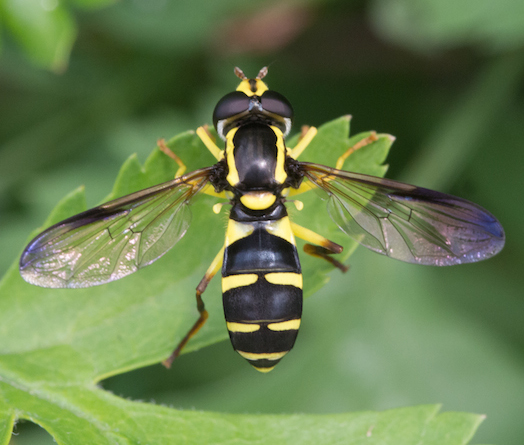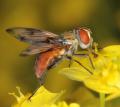Diptera.info :: Family forums :: Syrphidae
|
Xanthogramma dives? Help from Dutch speakers appreciated
|
|
| Carnifex |
Posted on 10-11-2017 07:08
|
|
Member Location: Vienna, Austria Posts: 1996 Joined: 23.06.15 |
Hi, this female Xanthogramma, which I identified as X. pedissequum, was recently suggested to be X. dives. I wondered if the infuscated wing tips are rather a reflection of light and also, if the hind legs shouldn't be darker for X. dives. There is yellow visible on the pleura just in front of the halteres - this should be a determining feature if I am correct? Are other diagnostic features visible in this image? You can find the observation here: https://observation.org/waarneming/view/102706847 Best, Lorin Carnifex attached the following image:  [157.96Kb] Edited by Carnifex on 11-11-2017 11:20 |
|
|
|
| Fred Fly |
Posted on 10-11-2017 09:33
|
|
Member Location: Germany Posts: 396 Joined: 19.07.11 |
X. dives Regards Piet |
|
|
|
| Carnifex |
Posted on 10-11-2017 17:14
|
|
Member Location: Vienna, Austria Posts: 1996 Joined: 23.06.15 |
Is this yellow part of the pleuron a/the determining feature?
Carnifex attached the following image:  [17.87Kb] |
|
|
|
| Fred Fly |
Posted on 10-11-2017 18:17
|
|
Member Location: Germany Posts: 396 Joined: 19.07.11 |
No. Regards Piet |
|
|
|
| Carnifex |
Posted on 10-11-2017 18:42
|
|
Member Location: Vienna, Austria Posts: 1996 Joined: 23.06.15 |
I asked this forum for help how to determine the species in the picture above. I don't want a simple name dropping, I want to learn and improve and I already mentioned with what features I am struggling with. By the two answers provided so far I learned almost nothing. So, I am asking again, on what features is the determination based? |
|
|
|
| binturong |
Posted on 11-11-2017 08:34
|
|
Member Location: Posts: 3075 Joined: 05.11.16 |
http://www.galerie-insecte.org/galerie/view.php?ref=96658 |
|
|
|
| Carnifex |
Posted on 11-11-2017 11:19
|
|
Member Location: Vienna, Austria Posts: 1996 Joined: 23.06.15 |
In my determination approach, I based my decision mainly on this publication. http://www.repository.naturalis.nl/document/645906 It is in Dutch, so I am not sure if I understood everthing correctly. As here are several Dutch speaking users in the forum it would be great if someone could explain to me how the yellow spots on the lateral thorax can help in determination. Dank u wel! |
|
|
|
| Fred Fly |
Posted on 11-11-2017 16:38
|
|
Member Location: Germany Posts: 396 Joined: 19.07.11 |
Sorry, I dont know any keys for determination of flies from pictures. If you prefer English publications you might use Google for search. Here you will find for example: https://diptera.info/downloads/StN_KEYS_Glasgow_2011.pdf or http://prodinra.inra.fr/ft?id=6E1CD73C-EFBD-4BC9-A04C-452A3F646C46 which you can find at the download area of this side: https://diptera.info/downloads/StN_Species_Accounts_Glasgow_2011.pdf. A paper which might answer some of your questions as well is: Speight M.C.D. & Sommaggio D. 2010. On the presence in Switzerland of Microdon myrmicae Schönrogge et al., 2002, Xanthogramma dives (Rondani, 1857) and X. stackelbergi Violovitsh, 1975. Entomo Helvetica 3: 139–145. Pleural spots are quite variable at least in X. pedissequum and X. dives as far as I remember from specimens I examined. Regards Piet |
|
|
|
| Carnifex |
Posted on 11-11-2017 18:33
|
|
Member Location: Vienna, Austria Posts: 1996 Joined: 23.06.15 |
I tried to access the Speight & Sommaggio paper in the first place, as it was referenced in another discussion here in this forum dealing with Xanthogramma (https://diptera.i...d_id=54819), but the link doesn't work anymore and I tried hard to find the PDF somewhere, to no avail. So I used the Dutch publication instead, which has a key and discusses in detail the difference between the three similar species. I am well aware how to use internet search engines. If someone could provide a link or send me the document (Speight & Sommaggio) it would be very much appreciated. If you, Piet, have more experience with these species and you know that the yellow spots are variable, why not telling me in first place? Because this is what I got from the Dutch document, that it is in fact a valuable feature. Maybe I translated it wrong or your experience contradicts some of the statements the authors made, however, a simple 'no' doesn't help me at all, just three or four more words would have been much more valuable for me. Best, Lorin |
|
|
|
| Leif Bloss Carstensen |
Posted on 07-12-2019 12:20
|
|
Member Location: Denmark Posts: 31 Joined: 15.09.14 |
There is also a key here: https://rua.ua.es/dspace/bitstream/10045/77172/5/2018_Nedeljkovic_etal_CanEntomol_revised.pdf The latest version of the Syrph the Net key that I could find is this one: https://pollinators.ie/wordpress/wp-content/uploads/2018/05/StN-2017-KEYS-to-SPECIES.pdf I am convinced that we also have X. dives in Denmark, but that it has been misidentified as X. stackelbergi. I identified all my specimens using the Dutch and the StN keys. The result: 7 X. dives, 9 X. pedissequum, 0 X stackelbergi. But I may be wrong, off course. 
Edited by Leif Bloss Carstensen on 07-12-2019 12:21 |
|
|
|
| helge |
Posted on 07-12-2019 18:22
|
|
Member Location: Austria Posts: 1322 Joined: 10.02.16 |
Carnifex wrote: I tried to access the Speight & Sommaggio paper in the first place, as it was referenced in another discussion here in this forum dealing with Xanthogramma (https://diptera.i...d_id=54819), but the link doesn't work anymore and I tried hard to find the PDF somewhere, to no avail. So I used the Dutch publication instead, which has a key and discusses in detail the difference between the three similar species. I am well aware how to use internet search engines. If someone could provide a link or send me the document (Speight & Sommaggio) it would be very much appreciated. If you, Piet, have more experience with these species and you know that the yellow spots are variable, why not telling me in first place? Because this is what I got from the Dutch document, that it is in fact a valuable feature. Maybe I translated it wrong or your experience contradicts some of the statements the authors made, however, a simple 'no' doesn't help me at all, just three or four more words would have been much more valuable for me. Best, Lorin Hi Lorin! Check your private mail. cheers, Helge |
|
|
|
| Valentin Nidergas |
Posted on 12-02-2020 20:41
|
|
Member Location: Savoie, France Posts: 79 Joined: 17.05.13 |
Xanthogramma sp. Ce wan't see the coloration of the pleurite membrane. |
|
|
|
| Ectemnius |
Posted on 12-02-2020 21:26
|
|
Member Location: The Netherlands Posts: 865 Joined: 22.11.11 |
Hello all, To help anyone with identifying Xanthogramma's heres my translation translation of van Steenis et.al. 2014. (I know, its not the best, but hope it helps) Kind regards, Ectemnius ------------------------------------------------------------------------------ 1a. Microtrichia on the mebranes between tergite en sternite iii and iv all yellow (fig. 3,5 ). Thorax laterally with four bright yellow spots (fig. 9). The points of the spots (pointing to the middle of the tergite) on tergite ii pointed or rounded. (fig. 6, 7). Dark spot behind the wing stigma expanding to maximally 1,25 celwidth (fig. 13 voor X. stackelbergi). Hairs on the edge of the lower calypter variable. Male: Spots on tergite ii variable (fig. 6, 7). Female: black stripe on frons variable (fig. 10, 11) -> 2 1b. Microtrichia on the mebranes between tergite en sternite iii and iv partly black (fig. 4). Thorax laterally never with four large yellow spots, often with one or two (fig. 8). If three or four spots are present than minimally anterior or posterior spot vage or reduced. The points of the spots (pointing to the middle of the tergite) on tergite ii sharp (fig. 6). Dark spot behind the wing stigma expanded to 1,3 celwidth or more (fig. 12). Hairs on edge of lower calypter brown. Male: Spots on tergite ii go across full width over the side of the tergite (fig. 6). Female: black stripe on frons connected to vertex. Anteriorly broadened and fully connected with lunula. (fig. 10). -> Xanthogramma pedissequum 2a. Inside of spots on tergite two rounded(fig. 7); the yellow spot on tergite two not connected with the edge of the tergite across entire width (fig. 7). Hairs on the edge of the lower calypter and plumula yellow. Dark spot behind the wing stigma limited to celwidth (fig. 13). The cel below (nearly) entirely hyaline. Wing tip: hyaline. Male: anterior edge of black band on sternite ii sharply pointing forward (fig. 5). Female: Black stripe on frons not reaching vertex or with a very small line connected with vertex. Towards lunula narrowed or at most not widening. (fig. 10) -> Xanthogramma stackelbergi ------------------------------------------------------------------------------ |
|
|
|
| Carnifex |
Posted on 12-02-2020 22:54
|
|
Member Location: Vienna, Austria Posts: 1996 Joined: 23.06.15 |
 Thanks! Thanks!
Cheers, Lorin Font Color All requests are from the urban area of Vienna, if not otherwise stated. My Diptera observations (and other living forms) can be found here, and corrections or comments over there would also be appreciated. |
|
|
|
| Jump to Forum: |













